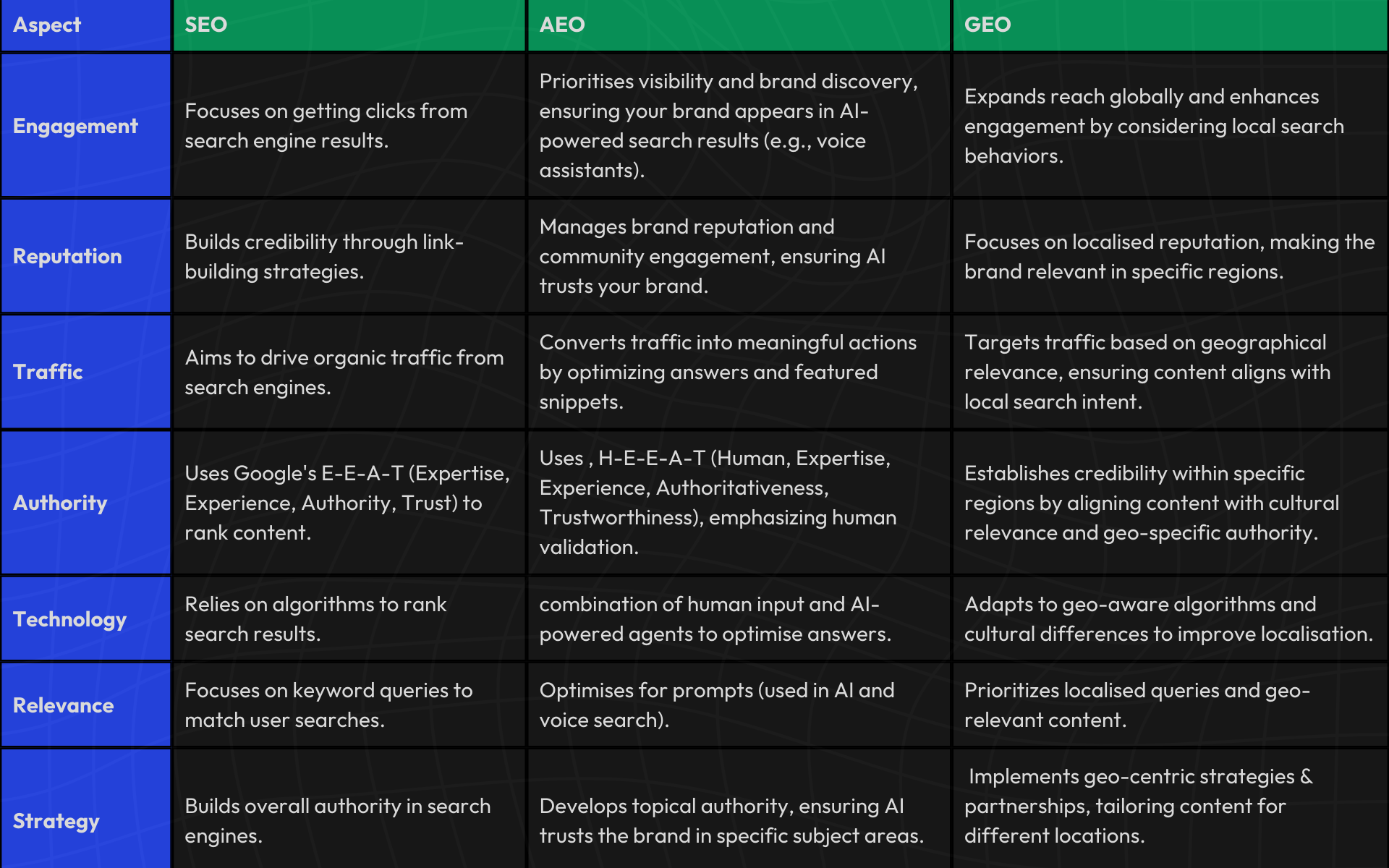The Role of AI in Search: Why AEO and GEO Matter
The emergence of AI-powered platforms like Google’s SGE (Search Generative Experience), ChatGPT, and Gemini is fundamentally reshaping how users interact with online content. This seismic shift moves beyond traditional keyword rankings and necessitates a new approach AI search optimisation to ensure content remains visible, authoritative, and preferred by these cutting-edge search tools
Search behaviour is evolving rapidly:
✅ 90.2% of the global search market still belongs to Google, but AI-driven search engines are gaining ground.
✅ 74.1% of the generative AI chatbot market is controlled by ChatGPT, demonstrating a shift in how people seek information.
✅ 53% of users prefer AI-powered answers over traditional search results, reflecting a demand for direct, concise information.
As AI tools reshape search dynamics, businesses need to optimise for both traditional SEO and AI-powered search to maintain visibility, credibility, and relevance in an increasingly automated landscape.
SEO: The Foundation of Digital Visibility
Search Engine Optimisation (SEO) remains the cornerstone of online visibility, ensuring that websites rank effectively on traditional search engines like Google and Bing. The core objective of SEO is to increase organic traffic by optimising content to align with search engine algorithms that determine web page rankings based on relevance, authority, and user experience.
Key Components of SEO:
✅ Keyword Optimisation – Using high-intent, relevant search terms to match user queries and improve discoverability.
✅ Technical SEO – Enhancing site structure, improving page speed, and ensuring mobile-friendliness for seamless user experience.
✅ Link Building – Acquiring authoritative backlinks to boost domain authority and enhance credibility.
✅ Content Quality – Crafting informative, engaging, and keyword-rich content that satisfies both user intent and search engine requirements.
✅ E-E-A-T (Expertise, Experience, Authoritativeness, Trustworthiness) – Google’s framework for evaluating content quality and reliability.
While SEO is still the foundation of online search, AI-driven search engines are changing the way content is discovered and ranked, prioritising direct, AI-friendly answers over traditional webpage listings.
AEO: Optimising for AI-Powered Answers
Answer Engine Optimisation (AEO) is the process of structuring content in a way that allows AI-powered search engines and digital assistants—like Google’s SGE, Siri, Alexa, and ChatGPT—to extract and present relevant, concise answers to user queries.
How AEO Works
When users interact with AI-driven platforms and ask questions such as “What’s the best way to save for retirement?”, they are looking for quick, authoritative responses—not lengthy blog posts. AEO ensures your content is optimised to be selected by AI search engines by making it structured, direct, and easily digestible.
How to Optimise for AEO:
✅ Think Like a Searcher – Understand natural language queries and create content that mirrors user search intent.
Example: Instead of “Investment Strategies,” use “What’s the Best Way to Invest My Money?”
✅ Use Schema Markup – Implement structured data formats like FAQ, How-To, and Article schemas to help AI understand content context.
✅ Optimise for Featured Snippets – Format responses using bullet points, numbered lists, and clear definitions to increase visibility in AI-generated search results.
✅ Use Conversational Language – Align content with the way people speak to AI assistants, making responses more intuitive and accessible.
✅ Provide Clear and Direct Answers – AI favours concise, well-structured, and authoritative content over vague or complex explanations.
Why AEO Matters: AI-powered search engines prioritise structured, relevant, and easily digestible content. If your content lacks these elements, it risks being overlooked in AI-generated responses, voice searches, and chatbot interactions.
GEO: Fueling AI with Quality Content
As AI-driven search engines generate responses based on pre-existing content sources, brands must ensure their information is accurate, authoritative, and well-structured to become the preferred reference. This is where Generative Engine Optimisation (GEO) comes into play.
How GEO Works
GEO ensures that AI-generated answers pull from high-quality, trusted content sources rather than unreliable or unstructured data. By optimising for GEO, businesses can improve their chances of being referenced by AI-generated search results, increasing their reach and authority.
How to Optimise for GEO:
✅ Build Authority & Trust – Ensure content is backed by reliable sources, expert opinions, and verifiable data.
✅ Organise for Clarity – Use structured headings, logical formatting, and well-defined sections to improve AI comprehension.
✅ Ensure Freshness – Regularly update content to reflect the latest trends, statistics, and industry developments.
✅ Optimise for AI Summarisation – AI models prefer well-structured, scannable content that can be summarised efficiently.
✅ Diversify Content Formats – AI analyses various content types, including text, images, video, and structured data—ensure your content is available in multiple formats to maximise reach.
Why GEO Matters: AI-powered search tools curate knowledge from vast datasets. By optimising content for GEO, businesses can position themselves as the authoritative source AI relies upon, enhancing their online presence and credibility.
SEO vs. AEO vs. GEO: Key Differences
Understanding the distinctions between SEO, AEO, and GEO is essential for refining a future-proof content strategy:

Future-Proof Your Search Strategy
AI-powered search is not a passing trend—it represents the future of digital discovery. Brands that fail to adapt to AEO and GEO risk losing visibility in an evolving search landscape dominated by AI-driven interactions.
Key Takeaways:
✅ SEO remains fundamental, but AI-driven search necessitates advanced optimisation strategies.
✅ AEO ensures content is structured for direct, AI-friendly responses in digital assistants and voice search.
✅ GEO helps AI search tools prioritise well-organised, credible content when generating answers.
✅ AI-driven search is already reshaping traditional search engines, making optimisation more crucial than ever.
Stay Ahead with Welcome Tomorrow
At Welcome Tomorrow, we are the first agency in Africa to offer AEO and GEO optimisation. If you want to future-proof your content strategy and gain a competitive edge, reach out to us today! 🚀